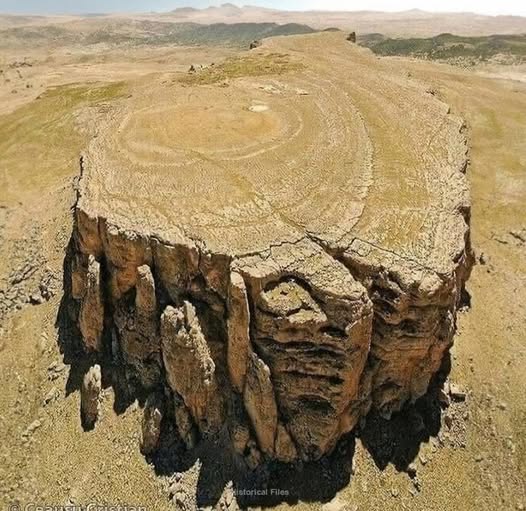
Ancient Giants Turned to Stone: The Theory of Petrified Tree Stump Mountains
The natural world is full of mysteries, and some landscapes appear to defy conventional geological explanations. Among these enigmas is the idea that certain mountains—particularly mesas, plateaus, and flat-topped formations—may not be merely the product of erosion and tectonic activity, but rather the remnants of ancient, colossal tree stumps that have undergone petrification. This concept, while unconventional, has sparked curiosity and debate among researchers, alternative theorists, and those fascinated by the possibility that Earth’s prehistoric landscape was vastly different from what we have been taught.
One of the most intriguing examples of this theory is the Jugurtha Tableland in Tunisia. This imposing mesa rises nearly 2,000 feet (600 meters) above the surrounding plains, stretching approximately 4,900 feet (1,500 meters) in length and 1,600 feet (500 meters) in width, covering nearly 80 hectares. Its nearly symmetrical, flat-topped shape, coupled with its sheer cliffs, evokes the image of a tree stump fossilized over eons. Could this be evidence that such geological formations are not mere rock but the remnants of a prehistoric forest of unimaginable scale?
Understanding Petrification: How Organic Matter Becomes Stone
To explore this idea, it is essential to understand the process of petrification. Petrification occurs when organic material is gradually replaced by minerals over time, typically through a process involving water saturated with dissolved minerals like silica, calcite, or pyrite. This slow replacement process preserves the original structure of the material while transforming it into stone. Fossilized wood is a well-documented example of this phenomenon, where tree trunks and branches have been discovered turned into stone, maintaining their bark patterns, rings, and even cellular structures.
Proponents of the ancient tree stump theory suggest that if relatively small trees can undergo petrification, it is conceivable that much larger biological structures could have also been subjected to the same process. This raises the question: Could some of Earth’s mesa-like formations be the petrified remains of ancient trees that towered thousands of feet into the sky?
Geological Explanations vs. Alternative Theories
The mainstream geological explanation for formations like the Jugurtha Tableland attributes their existence to sedimentary processes, uplift, and erosion. Over millions of years, layers of sediment were deposited, compacted, and eventually uplifted by tectonic forces. Subsequent erosion removed the softer surrounding rock, leaving behind the harder, more resistant rock that forms the plateaus and mesas seen today.
However, those who question this interpretation argue that some of these formations possess characteristics strikingly similar to the cross-sections of tree stumps. They point to the hexagonal patterns found in certain rock formations, such as the Giant’s Causeway in Northern Ireland, as potential evidence of ancient tree-like structures. These geometric shapes resemble the cellular structures of plant matter, leading some to wonder whether mainstream science has overlooked a deeper, more ancient explanation for these formations.
Ancient Myths and Cultural Connections
The idea of colossal ancient trees is not purely speculative—it has roots in mythology and folklore from cultures around the world. Many ancient civilizations spoke of a time when the Earth was home to enormous trees that connected the heavens and the land. The Norse spoke of Yggdrasil, the immense world tree that held the cosmos together. In Mesoamerican mythology, the ceiba tree was believed to serve as a bridge between different realms. Even in biblical texts, references to great trees that provided shelter and sustenance hint at an era when such giants may have existed.
Could it be that these myths are more than mere allegories? If such massive trees once flourished, their petrified remains might still be standing today in the form of plateaus and mesas.
Examining Other Potential Petrified Tree Stump Sites
Beyond the Jugurtha Tableland, other geological structures around the world exhibit features that fuel this theory.
- Devils Tower, USA: This iconic butte in Wyoming has a distinctive columnar structure that bears an uncanny resemblance to the fibrous strands of a tree trunk. Its hexagonal basalt columns have led some to speculate that it could be the remains of an enormous tree.
- Uluru, Australia: Also known as Ayers Rock, this massive sandstone formation rises dramatically from the desert, its smooth and rounded edges suggesting a weathered tree stump.
- Tepuis of South America: These flat-topped plateaus in Venezuela and Brazil, such as Mount Roraima, appear as if they could be the remnants of an ancient, petrified forest towering over the Amazon.
- Table Mountain, South Africa: A strikingly level plateau, this formation’s shape has led some to wonder whether it was once part of a vast prehistoric ecosystem.
Each of these locations exhibits structural features that, at least to the untrained eye, resemble enormous fossilized stumps. While mainstream science attributes their formation to natural geological processes, the visual similarities to wood cross-sections have kept the petrified tree theory alive among those who dare to rethink Earth’s history.
Could Such Giant Trees Have Existed?
For the tree stump theory to hold weight, one must consider the possibility that prehistoric Earth could have supported trees of such immense proportions. Some theorists suggest that Earth’s atmosphere was once vastly different, with higher oxygen levels and atmospheric pressures that could have supported the growth of megaflora. Fossil evidence shows that during the Carboniferous period, around 300 million years ago, Earth was home to enormous plants, including tree-like lycophytes that grew over 100 feet tall.
While this is far from the size required to explain mesa formations as former trees, it does suggest that past environmental conditions were capable of sustaining much larger plant life than what we see today. Could an even earlier epoch have witnessed the growth of truly massive trees that dwarfed modern sequoias?
The Debate Between Science and Speculation
Skeptics argue that there is no direct evidence linking mesas and buttes to ancient tree stumps. Geological studies overwhelmingly support the natural formation of these structures through known processes like erosion, sedimentation, and volcanic activity. However, proponents of the ancient tree theory point out that much of mainstream science is based on existing paradigms that resist radical reinterpretations.
The idea that Earth’s landscape could once have been dominated by colossal trees is certainly an exciting one, sparking the imagination of those who ponder lost worlds and forgotten histories. Whether or not scientific evidence will ever validate this hypothesis, the resemblance of certain geological formations to tree stumps continues to captivate researchers, theorists, and curious minds alike.
Conclusion: A Mystery Set in Stone
The notion that some of Earth’s most famous mesa formations might be the petrified remnants of ancient, giant trees remains an open-ended mystery. While mainstream geology offers well-supported explanations for these structures, the striking visual resemblance between certain plateaus and tree stumps fuels speculation that Earth’s history may hold secrets yet to be uncovered. Whether the Jugurtha Tableland and other similar formations are merely natural landforms or something more, their towering presence invites us to question the past and reconsider the possibilities of a world lost to time.
